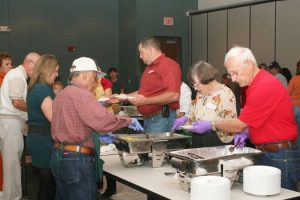It’s deja vu all over again. In November 2015 over 40 fell ill with Clostridium perfringens in my home state of North Carolina following a Thanksgiving community meal.
The caterer failed to keep the hot foods hot according to the investigation report in MMWR:
Turkeys were cooked approximately 10 hours before lunch, placed in warming pans, and plated in individual servings. Food was then delivered by automobile, which required multiple trips. After cooking and during transport, food sat either in warming pans or at ambient temperature for up to 8 hours. No temperature monitoring was conducted after cooking.
Today, according to the LA Times, perfringens has been linked to another Thanksgiving outbreak. This one was fatal.
Health officials say common foodborne bacteria caused an illness that left three people dead and sickened 22 others who attended a Thanksgiving dinner at an events hall in Antioch, Calif.
Officials identified the three people who died as 43-year-old Christopher Cappetti, 59-year-old Chooi Keng Cheah, and 69-year-old Jane Evans. All were residents of assisted living facilities in Antioch.
From a Contra Costa County press release:
A laboratory at the U.S. Centers for Disease Control & Prevention (CDC) confirmed the presence of the bacteria in stool samples taken from people sickened by food served at the Nov. 24 holiday celebration, held by a community church at Antioch’s American Legion auditorium.
“Our investigation was not able to determine exactly what people ate that made them sick. But after extensive interviews we found most of the ill people ate turkey and mashed potatoes and they all ate around the same time. Some dishes served at the event, including cooked turkey, were brought to the site after they were prepared in private homes,” said Dr. Marilyn Underwood, CCHS Environmental Health director.




